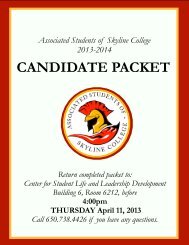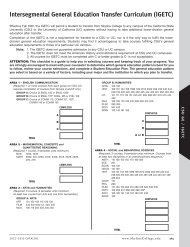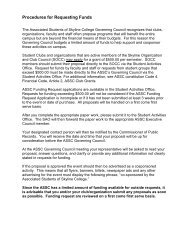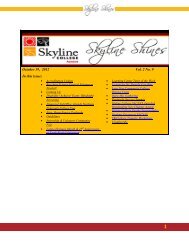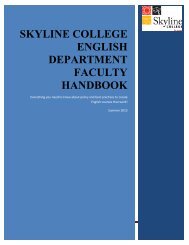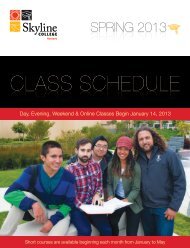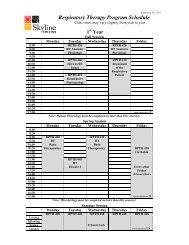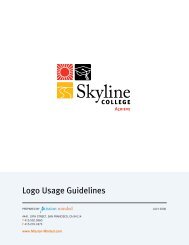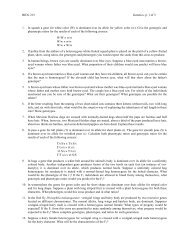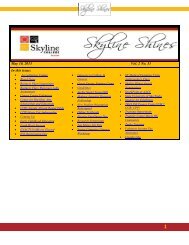Skyline College Catalog 2011-2012 Program & course descriptions ...
Skyline College Catalog 2011-2012 Program & course descriptions ...
Skyline College Catalog 2011-2012 Program & course descriptions ...
You also want an ePaper? Increase the reach of your titles
YUMPU automatically turns print PDFs into web optimized ePapers that Google loves.
TELECOMMUNICATIONS AND NETWORK INFORMATION TECHNOLOGYC O U R S E D E S C R I P T I O N STCOM 312 INSTALLING/USING LINUX ASYOUR PC OS (1.5)(Pass/No Pass or letter grade.)Minimum of 24 lecture hours plus lab hours by arrangement/semester.A first <strong>course</strong> on installing and using Linux as the operatingsystem running on an Intel-compatible PC or workstationcomputer. Topics include creating installationmedia, installing Linux, Linux file system concepts, usingthe graphical desktop interface, beginning shell (commandline) usage, updating the system, and configuringaccess to common network services. After successfulcompletion of this <strong>course</strong>, students will be confidentinstalling and using common Linux distributions (e.g., RedHat, Fedora, SUSE, Ubuntu) on a home or work PC. Alsolisted as COMP 312. May be repeated once for credit.Transfer credit: CSU.TCOM 313 WORKING IN A LINUX SHELLENVIRONMENT (1.5)(Pass/No Pass or letter grade.)Minimum of 24 lecture hours plus 8 lab hours by arrangement/semester.Recommended: Satisfactory completion(grade of C or better) of TCOM/COMP 312, or equivalentexperience using a Linux desktop system.A <strong>course</strong> on using the Linux shell (command line) environment.Topics include comparing the Linux graphicaldesktop environment and the shell environment, shellcommands for file system usage, shell features for productivityand customization (history, completion, aliases,environment files), advanced shell features (regularexpressions, redirection, pipelines), introduction to shellscripts and shell commands for process managementand remote system access. After successful completionof this <strong>course</strong>, students will be confident using the bashshellenvironment found on common Linux distributions(e.g., Red Hat, Fedora, SUSE, Ubuntu). Also listed asCOMP 313. May be repeated once for credit. Transfercredit: CSU.TCOM 314 MANAGING A LINUX SYSTEM (1.5)(Pass/No Pass or letter grade.)Minimum of 24 lecture hours plus 8 lab hours by arrangement/semester.Prerequisite: Satisfactory completion (grade ofC or better) of TCOM/COMP 312, or equivalent experienceinstalling or using a Linux system, or equivalent.An intermediate <strong>course</strong> on administering a Linux system.Designed for individuals who have installed Linux butwho now want a hands-on exposure to key concepts,issues and capabilities for managing a Linux system.Topics include installing from alternate media sources(network installs), managing disk devices (defining partitions,creating file systems, and mounting/un-mountingfile systems), creating multi-boot systems and boot loadermenus, using run levels including trouble-shooting withsingle user mode, and maintaining system softwareincluding installing from source code and recompiling kernels.The focus of this <strong>course</strong> is on developing expertisefor managing a given Linux system (as opposed to managingservices provided to other systems). After successfulcompletion of this <strong>course</strong>, students will be confident inmanaging a system with a common Linux distribution(e.g., Red Hat, Fedora, SUSE, Ubuntu). Also listed asCOMP 314. May be repeated once for credit. Transfercredit: CSU.TCOM 315 MANAGING LINUX-BASED INTERNETSERVICES (3)(Pass/No Pass or letter grade.)Minimum of 48 lecture hours plus 16 lab hours by arrangement/semester.Prerequisite: TCOM/COMP 314 or equivalentexperience installing and managing a Linux system,and TCOM/CAOT 480 or equivalent experience usinglocal area networks, or equivalent. Recommended:TCOM/COMP 313 or equivalent experience using theLinux bash-shell.An intermediate <strong>course</strong> on managing Linux-basedInternet services. Designed for individuals who haveexperience installing and managing Linux systems, butnow want a hands-on exposure to the concepts, issuesand capabilities for providing public Internet servicesbased on Linux servers. Topics include selecting serverfunctionality during a Linux installation, configuring nameservices (DNS) for a custom domain name, hosting Webpages and configuring management of Web pages, providingsecure Web page connections, providing remoteaccess, providing email services, connecting to databasesfor dynamic Web page hosting, and installing frompackages vs. source code. This <strong>course</strong> focuses onadministering Linux-based Internet servers that providecommon services found on the public Internet. After successfulcompletion of this <strong>course</strong>, students will be confidentin providing Internet services using a common Linuxdistribution (e.g., Red Hat, Fedora, SUSE, Ubuntu). Alsolisted as COMP 315. May be repeated once for credit.Transfer credit: CSU.232 w w w. S k y l i n e C o l l e g e . e d u <strong>2011</strong> – 2 012 C ATA L O G



